Link Investigation of IEEE 802.15.4 Wireless Sensor Networks in Forests
Abstract
:1. Introduction
2. Experimental Methodologies
2.1. Study Sites
2.2. Experimental Setup
2.2.1. Wireless Standard and Sensor Node
2.2.2. Software Configuration
2.3. Metrics
- PRR: If node A sends n packets to node B and B correctly receives packets, then the PRR of the link from A to B is equal to . Calculated at the receiver side, PRR is often used as a benchmark metric for link reliability in wireless protocol design and operation, especially in routing protocols.
- RSSI: This is a reading calculated by a receiver’s radio chip, which generally is the average of the signal strength of eight-symbol periods. For the TelosB node, which integrates the CC2420 radio chip, the returned RSSI value ranges from −100 dBm to 0 dBm. The RSSI involves not only the received signal, but the background noise, and generally, the received signal is hard to discern from noise when the returned RSSI is lower than −90 dBm.
- LQI: The receiver can measure the strength quality of a successfully received packet by calculating the average correlation of the first eight symbols of this packet. LQI is often used to approximate the chip error rate. The TelosB node produces an LQI value of at most 110 and at least 50.
3. Performance of Single Link
3.1. Experiment Designs
3.2. Effect of Distance and In-Forest Surroundings
3.3. Asymmetry of the Link
3.4. Propagation Analysis
4. Performance of In-Network Links
4.1. Deployment and Experiment Designs
4.2. PRR of In-Network Links
4.3. Exploring Link Correlation
5. Summary of Observations
6. Related Work
7. Conclusions
Acknowledgments
Author Contributions
Conflicts of Interest
References
- Yick, J.; Mukherjee, B.; Ghosal, D. Wireless sensor network survey. Comput. Netw. 2008, 52, 2292–2330. [Google Scholar] [CrossRef]
- Singh, R.; Murty, H.; Gupta, S.; Dikshit, A. An overview of sustainability assessment methodologies. Ecol. Indic. 2010, 15, 281–299. [Google Scholar] [CrossRef]
- Xu, G.; Shen, W.; Wang, X. Applications of wireless sensor networks in marine environment monitoring: A survey. Sensors 2014, 14, 16932–16954. [Google Scholar] [CrossRef] [PubMed]
- Rashid, B.; Rehmani, M.H. Applications of wireless sensor networks for urban areas: A survey. J. Netw. Comput. Appl. 2015, 60, 192–219. [Google Scholar] [CrossRef]
- Grassini, S.; Ishtaiwi, M.; Parvis, M.; Vallan, A. Design and deployment of low-cost plastic optical fiber sensors for gas monitoring. Sensors 2015, 15, 485–498. [Google Scholar] [CrossRef] [PubMed]
- Sun, G.; Hu, T.; Yang, G. Real-time and clock-shared rainfall monitoring with a wireless sensor network. Comput. Electron. Agric. 2015, 119, 1–11. [Google Scholar] [CrossRef]
- Gnawali, O.; Fonseca, R.; Jamieson, K.; Moss, D.; Levis, P. Collection tree protocol. In Proceedings of the 7th ACM Conference on Embedded Networked Sensor Systems (SenSys 2009), Berkeley, CA, USA, 4–6 November 2009; pp. 1–14.
- Nazabal, J.; Fernandez-Valdivielso, C.; Matias, I. Development of a low mobility IEEE 802.15.4 compliant VANET system for urban environments. Sensors 2013, 13, 7065–7078. [Google Scholar] [CrossRef] [PubMed]
- Tunca, C.; Isik, S.; Donmez, M.; Ersoy, C. Distributed mobile sink routing for wireless sensor networks: A survey. IEEE Commun. Surv. Tutor. 2013, 16, 877–897. [Google Scholar] [CrossRef]
- Lee, H.; Kim, H.; Chang, I. CPAC: Energy-efficient data collection through adaptive selection of compression algorithms for sensor networks. Sensors 2014, 14, 6419–6442. [Google Scholar] [CrossRef] [PubMed]
- Canete, F.; Lopez-Fernandez, J.; Garcia-Corrales, C.; Sanchez, A.; Robles, E.; Rodrigo, F.; Paris, J. Measurement and modeling of narrowband channels for ultrasonic underwater communications. Sensors 2016, 16, 1–12. [Google Scholar] [CrossRef] [PubMed]
- IEEE Wireless Personal Area Network (WPAN) Working Group. 802.15.4-2006: IEEE Standard for Information Technology—Local and Metropolitan Area Networks. Available online: https://standards.ieee.org/findstds/standard/802.15.4-2006.html (accessed on 25 June 2006).
- Gast, M. 802.11 Wireless Networks: The Definitive Guide, 2nd ed.; OReilly, Southeast University Press: Nanjing, China, 2006. [Google Scholar]
- Goldsmith, A. Wireless Communications (Reprint); Posts and Telecom Press: Beijing, China, 2007. [Google Scholar]
- Zuniga, M.; Krishnamachari, B. Analyzing the transmissional region in low power wireless links. In Proceedings of the 2004 First Annual IEEE Communications Society Conference on Sensor and Ad Hoc Communications and Networks, Santa Clara, CA, USA, 4–7 October 2004; pp. 517–526.
- Demirko, I.; Ersoy, C.; Alagoz, F. MAC protocols for wireless sensor networks: A survey. IEEE Commun. Mag. 2005, 3, 1463–1469. [Google Scholar]
- Baccour, N.; Koubaa, A.; Mottola, L.; Zuniga, M.; Youssef, H.; Boano, C.; Alves, M. Radio link quality estimation in wireless sensor networks: A survey. ACM Trans. Sens. Netw. 2012, 8, 1–33. [Google Scholar] [CrossRef] [Green Version]
- Aslan, Y.; Korpeoglu, I.; Ulusoy, O. A framework for use of wireless sensor networks in forest fire detection and monitoring. Comput. Environ. Urban Syst. 2010, 36, 614–625. [Google Scholar] [CrossRef]
- Qu, Y.; Han, W.; Fu, L.; Li, C.; Song, J. LAINet-a wireless sensor network for coniferous forest leaf area index measurement: Design, algorithm and validation. Comput. Electron. Agric. 2014, 108, 200–208. [Google Scholar] [CrossRef]
- Ojha, T.; Misraa, S.; Raghuwanshib, N. Wireless sensor networks for agriculture: The state-of-the-art in practice and future challenges. Comput. Electron. Agric. 2015, 118, 66–84. [Google Scholar] [CrossRef]
- Moteiv Coorperation. Tmote Sky: Ultra Low Power IEEE 802.15.4 Compliant Wireless Sensor Module. Available online: http://www.moteiv.com (accessed on 25 June 2016).
- Chipcon Products from Texas Instruments. 2.4 GHz IEEE 802.15.4 / ZigBee-Ready RF Transceiver CC2420; Texas Instruments: Dallas, TX, USA, 2009. [Google Scholar]
- Cerpa, A.; Wong, J.; Kuang, L.; Potkonjak, M.; Estrin, D. Statistical model of lossy links in wireless sensor networks. In Proceedings of the 4th International Symposium on Information Processing in Sensor Networks (IPSN’05), Los Angeles, CA, USA, 24–27 April 2005; pp. 81–88.
- Srinivasan, K.; Dutta, P.; Tavakoli, A.; Levis, P. An emperical study of low-power wireless. ACM Trans. Sens. Netw. 2010, 6, 1–49. [Google Scholar] [CrossRef]
- Srinivasan, K.; Jain, M.; Choi, J.I.; Azim, T.; Kim, E.; Levis, P.; Krishnamachari, B. The k factor: Inferring protocol performance using inter-link reception correlation. In Proceedings of the 16th Annual International Conference on Mobile Computing and Networking (MobiCom’10), Chicago, IL, USA, 20–24 September 2010; pp. 317–328.
- Zhu, T.; Zhong, Z.; He, T.; Zhang, Z. Exploring link correlation for efficient flooding in wireless sensor networks. In Proceedings of the 7th USENIX Conference on Networked Systems Design and Implementation (NSDI’10), San Jose, CA, USA, 28–30 April 2010; pp. 49–64.
- Diallo, O.; Rodrigues, J.; Sene, M. Real-time data management on wireless sensor networks: A survey. J. Netw. Comput. Appl. 2012, 35, 1013–1021. [Google Scholar] [CrossRef]
- Srinivasan, K.; Levis, P. RSSI is Under Appreciated. In Proceedings of the Workshop on Embedded Networked Sensors, Boulder, CO, USA, 31 October–3 November 2006; pp. 239–242.
- Zhou, G.; He, T.; Krishnamurthy, S.; Stankovic, J. Models and solutions for radio irregularity in wireless sensor networks. ACM Trans. Sens. Netw. 2006, 2, 221–262. [Google Scholar] [CrossRef]
- Zamalloa, M.; Krishnamachari, B. An analysis of unreliability and asymmetry in low-power wireless links. ACM Trans. Sens. Netw. 2007, 3, 1–34. [Google Scholar] [CrossRef]
- Tang, L.; Wang, K.C.; Huang, Y.; Gu, F. Channel characterization and link quality assessment of IEEE 802.15.4-compliant radio for factory environments. IEEE Trans. Ind. Inform. 2007, 3, 99–110. [Google Scholar] [CrossRef]
- Can, Z.; Demirbas, M. Smartphone-based data collection from wireless sensor networks in an urban environment. J. Netw. Comput. Appl. 2015, 2015. [Google Scholar] [CrossRef]
- Mendes, L.; Rodrigues, J. A survey on cross-layer solutions for wireless sensor networks. J. Netw. Comput. Appl. 2011, 34, 523–534. [Google Scholar] [CrossRef]
- Aguayo, D.; Bicket, J.; Biswas, S.; Judd, G.; Morris, R. Link-level measurements from an 802.11b mesh network. In Proceedings of the ACM SIGCOMM 2004, Portland, OR, USA, 30 August–3 September 2004; pp. 121–132.
- Mottola, L.; Ceriotti, M.; Guna, S.; Murphy, A. Not all wireless sensor networks are created equal: A comparative study on tunnels. ACM Trans. Sens. Netw. 2010, 7, 1–33. [Google Scholar] [CrossRef]
- Liu, Y.; He, Y.; Li, M.; Wang, J.; Liu, K.; Mo, L.; Dong, W.; Yang, Z.; Xi, M.; Zhao, J.; et al. Does wireless sensor network scale? A measurement study on GreenOrbs. IEEE Trans. Parallel Distrib. Syst. 2013, 24, 1983–1993. [Google Scholar] [CrossRef]
- Bannister, K.; Giorgetti, G.; Gupta, E. Wireless sensor networking for “hot” applications: Effects of temperature on signal strength, data collection and localization. In Proceedings of the 5th Workshop on Embedded Networked Sensors (HotEmNets), Charlottesville, VA, USA, 2–3 June 2008.
- Boano, C.; Wennerstrom, H.; Zuniga, M. Hot packets: A systematic evaluation of the effect of temperature on low power wireless transceivers. In Proceedings of the 5th Extreme Conference on Communication (ExtremeCom), Þórsmörk, Iceland, 24–30 August 2013; pp. 7–12.
- Marfievici, R.; Murphy, A.; Picco, G.; Ossi, F.; Cagnacci, F. How environmental factors impact outdoor wireless sensor networks: A case study. In Proceedings of the 10th IEEE International Conference on Mobile Ad-hoc and Sensor Systems, Hangzhou, China, 14–16 October 2013; pp. 565–573.
- Marfievici, R. Measuring, Understanding, and Estimating the Influence of the Environment on Low-power Wireless Networks. Ph.D. Thesis, University of Trento, Trento, Italy, 2015. [Google Scholar]
- Rankine, C.; Sanchez-Azofeifa, G.; MacGregor, M. Seasonal wireless sensor network link performance in boreal forest phenology monitoring. In Proceedings of the 11th IEEE International Conference on Mobile Ad hoc and Sensor Systems, Philadelphia, PA, USA, 27–30 October 2014; pp. 302–310.
- Raman, B.; Chebrolu, K.; Gokhale, D.; Sen, S. On the Feasibility of the Link Abstraction in Wireless Mesh Networks. IEEE/ACM Trans. Netw. 2009, 17, 528–541. [Google Scholar] [CrossRef]
- Meng, Y.; Lee, Y.; Ng, B. Path loss modeling for nearground vhf radiowave propagation through forests with tree-canopy reflection effect. Prog. Electromagn. Res. 2010, 12, 131–141. [Google Scholar] [CrossRef]
- Gay-Fernandez, J.; Sanchez, M.; Cuinas, I.; Alejos, A.; Sanchez, J.; Miranda-Sierra, J. Propagation analysis and deployment of a wireless sensor network in a forest. Prog. Electromagn. Res. 2010, 106, 121–145. [Google Scholar] [CrossRef]
- Balachander, D.; Rao, T.; Mahesh, G. RF propagation experiments in agricultural fields and gardens for wireless sensor communications. Prog. Electromagn. Res. 2013, 39, 103–118. [Google Scholar] [CrossRef]
- Sabri, N.; Aljunid, S.; Salim, M.; Kamaruddin, R.; Ahmad, R.; Malek, M. Path loss analysis of WSN wave propagation in vegetation. J. Phys. 2013, 423, 1–10. [Google Scholar] [CrossRef]
- Azpilicueta, L.; Lopez-Iturri, P.; Aguirre, E.; Mateo, I.; Astrain, J.; Villadangos, J.; Falcone, F. Analysis of radio wave propagation for ISM 2.4 GHz wireless sensor networks in inhomogeneous vegetation environments. Sensors 2014, 14, 23650–23672. [Google Scholar] [CrossRef] [PubMed]
- Kurnaza, O.; Helhel, S. Near ground propagation model for pine tree forest environment. Int. J. Electron. Commun. 2014, 68, 944–950. [Google Scholar] [CrossRef]
- Men, Y.; Lee, Y.; Ng, B. Empirical near ground path loss modeling in a forest at VHF and UHF bands. IEEE Trans. Antennas Propag. 2009, 57, 1461–1468. [Google Scholar]
- Barac, F.; Gidlund, M.; Zhang, T. Scrutinizing bit-and symbol-errors of IEEE 802.15.4 communication in industrial environments. IEEE Trans. Instrum. Meas. 2014, 63, 1783–1794. [Google Scholar] [CrossRef]
- Son, D.; KrishnamachariK, B.; Heidemann, J. Experimental analysis of concurrent packet transmissions in wireless sensor networks. In Proceedings of the 4th Conference on Embedded Networked Sensor Systems (SenSys), Boulder, CO, USA, 1–3 November 2006.
- Markham, A.; Trigoni, N.; Ellwood, S. Effect of rainfall on link quality in an outdoor forest deployment. In Proceedings of the 2010 International Conference on Wireless Information Networks and Systems (WINSYS), Athens, Greece, 26–28 July 2010; pp. 1–6.

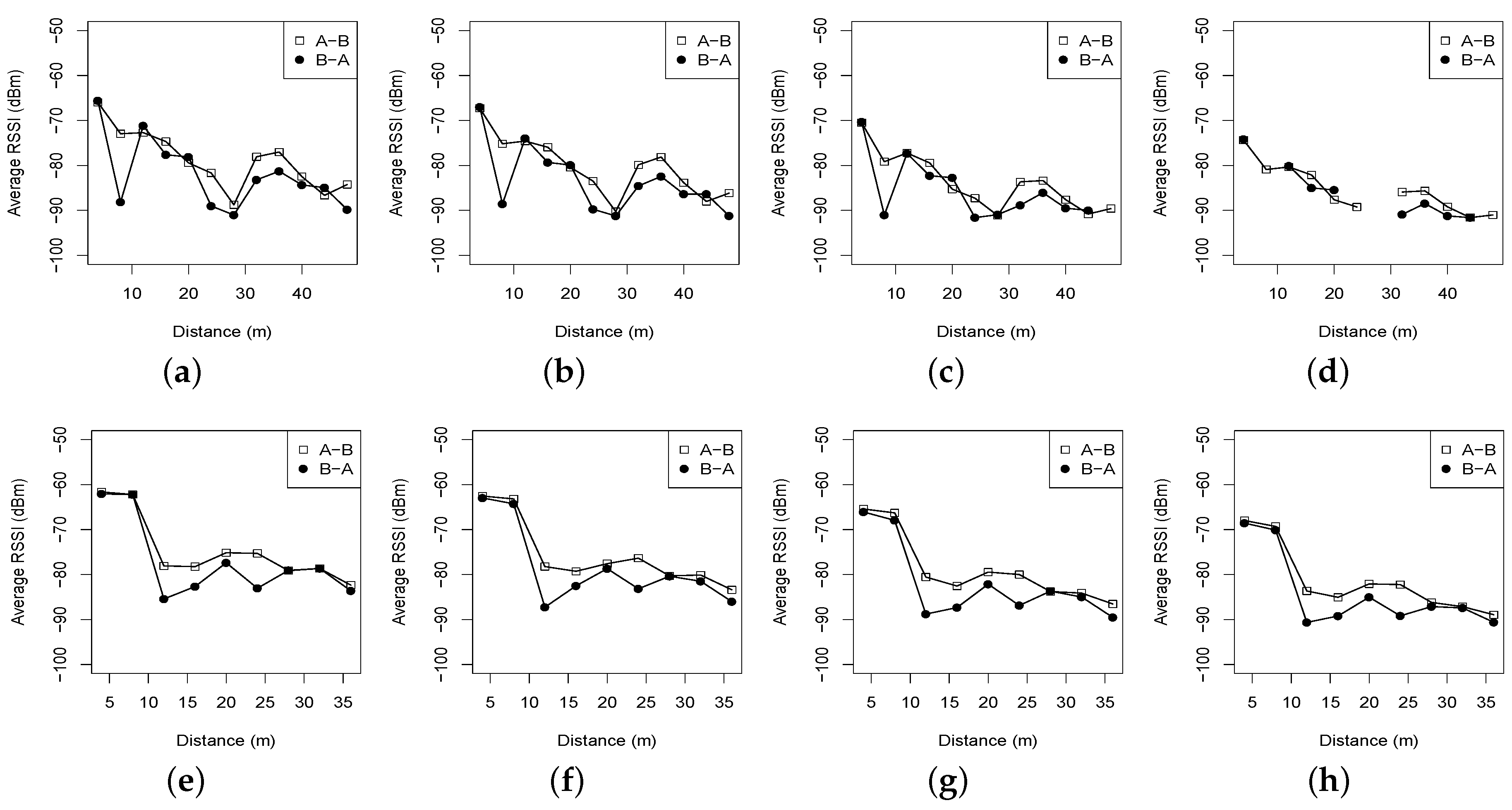
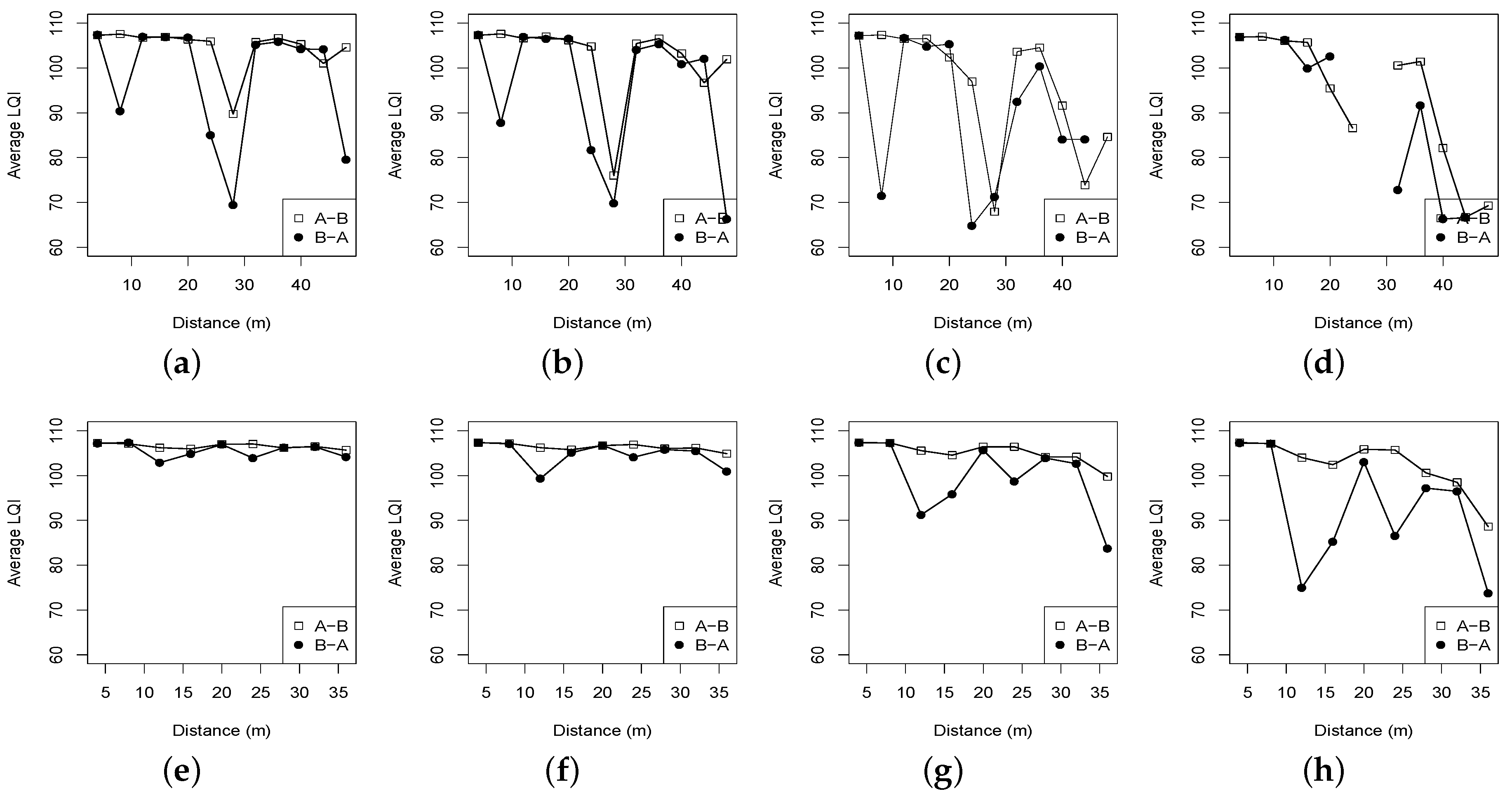


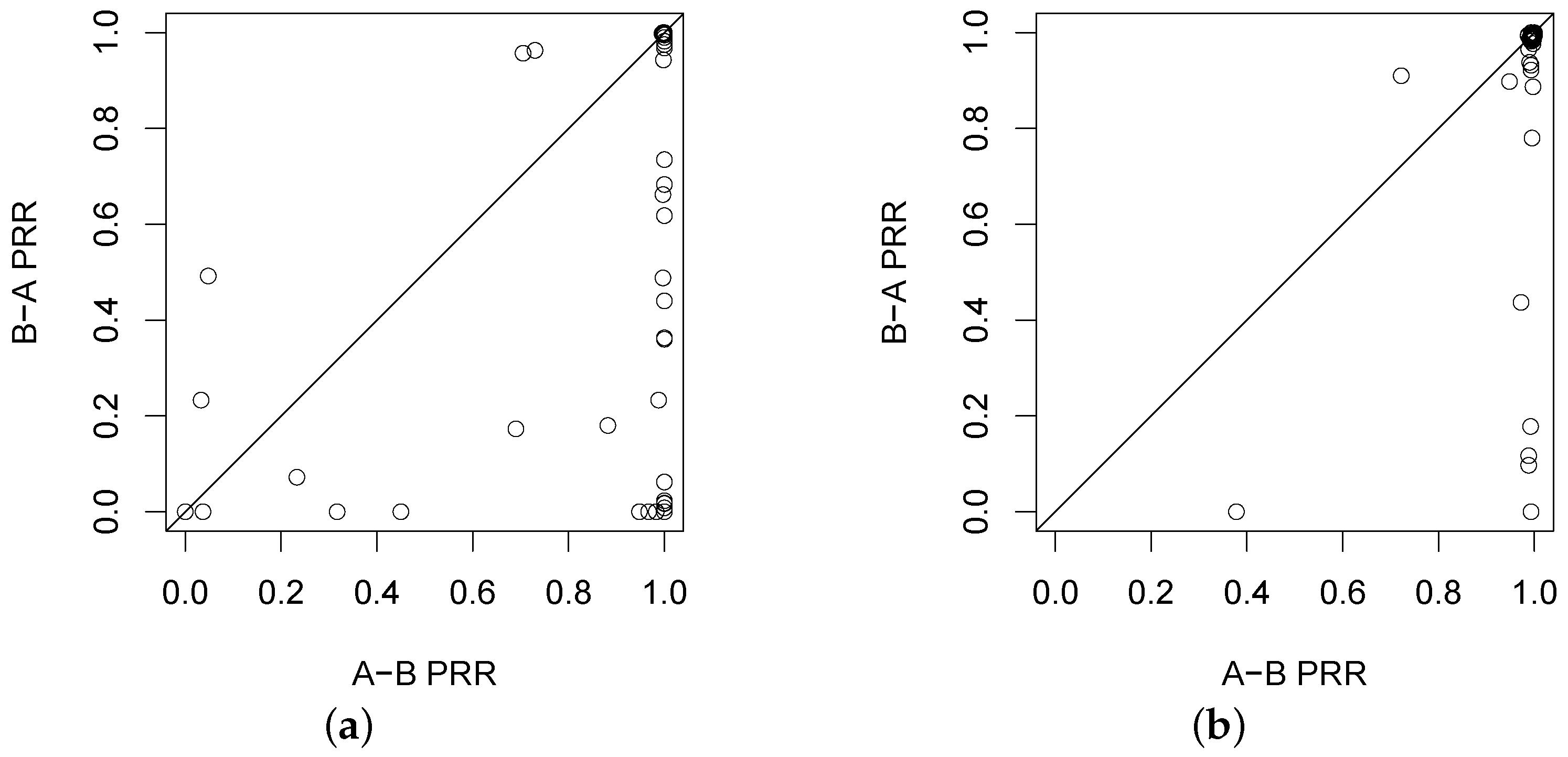
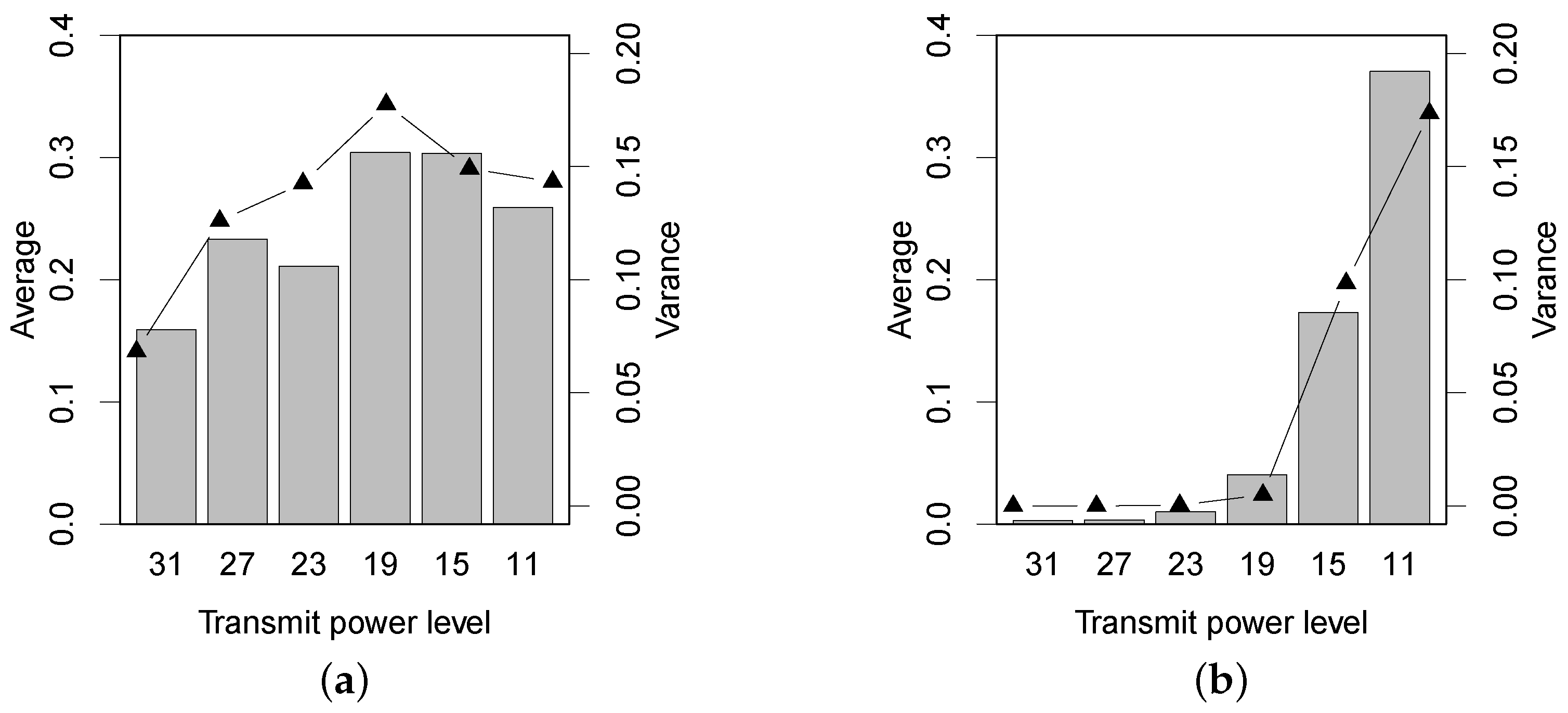
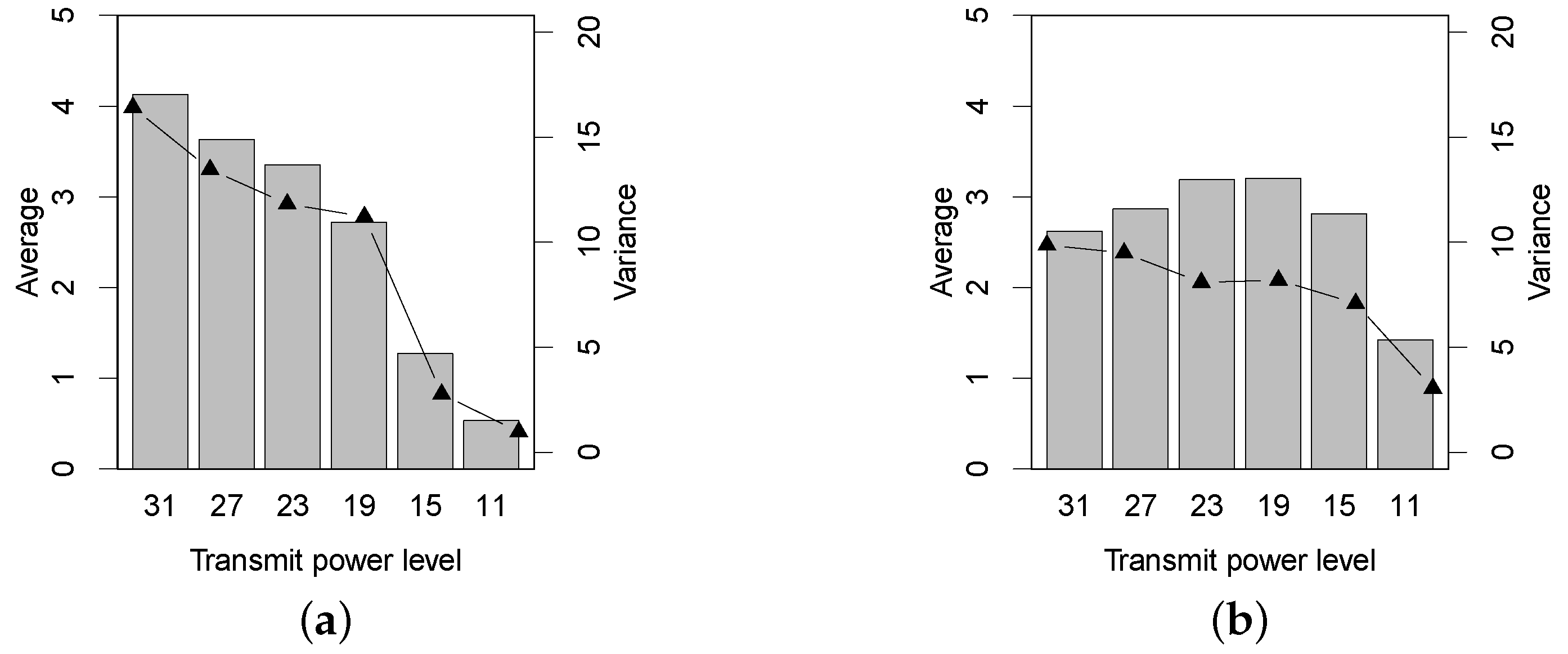
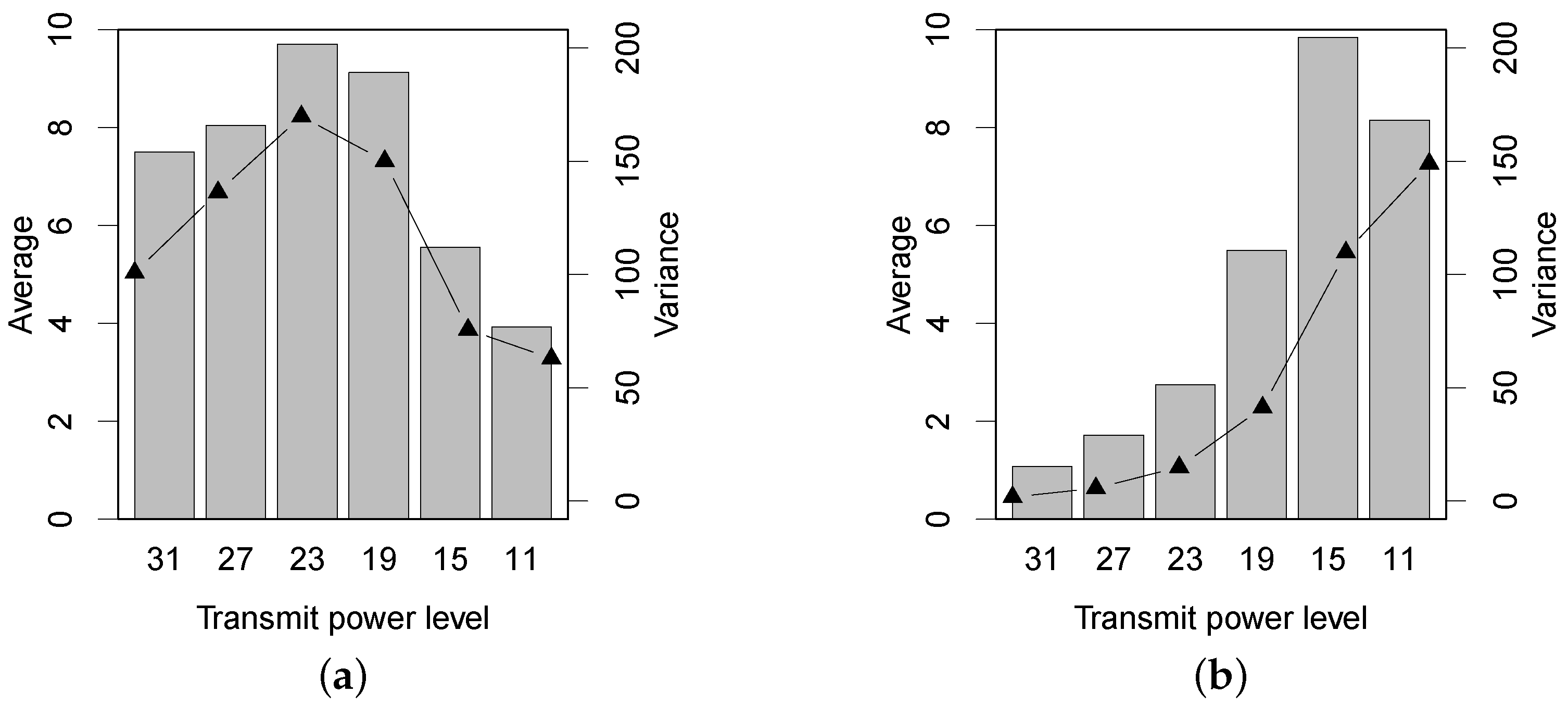
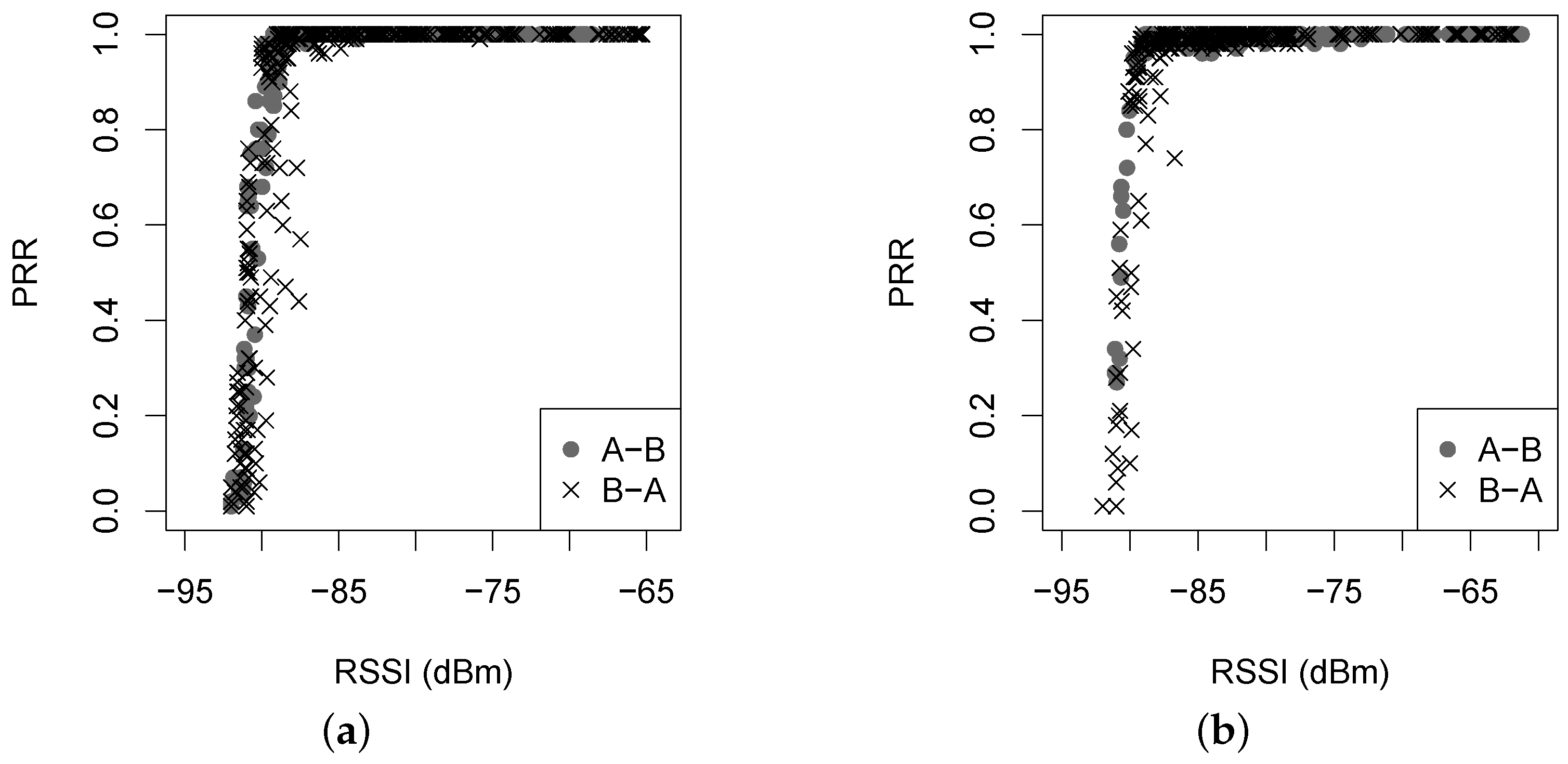
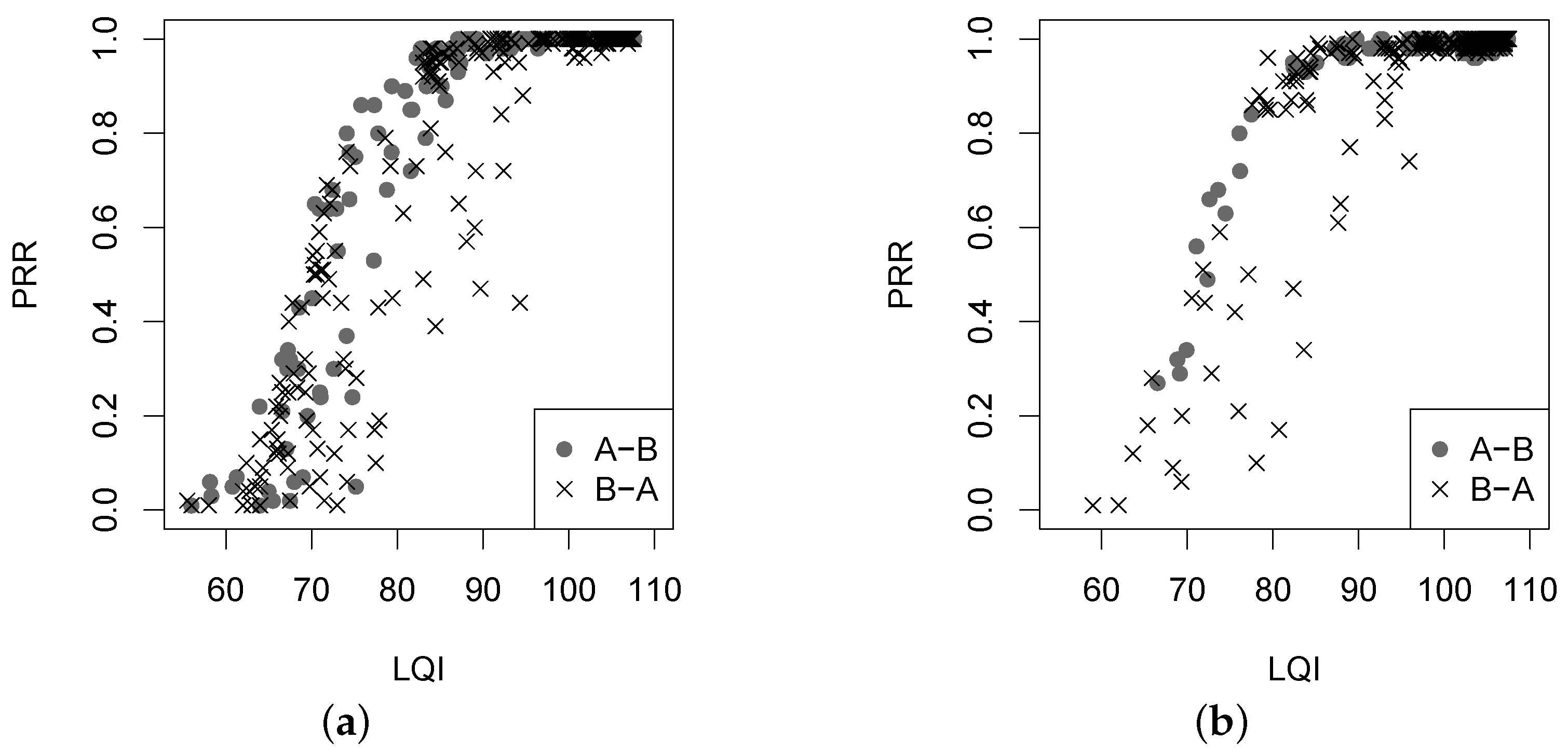
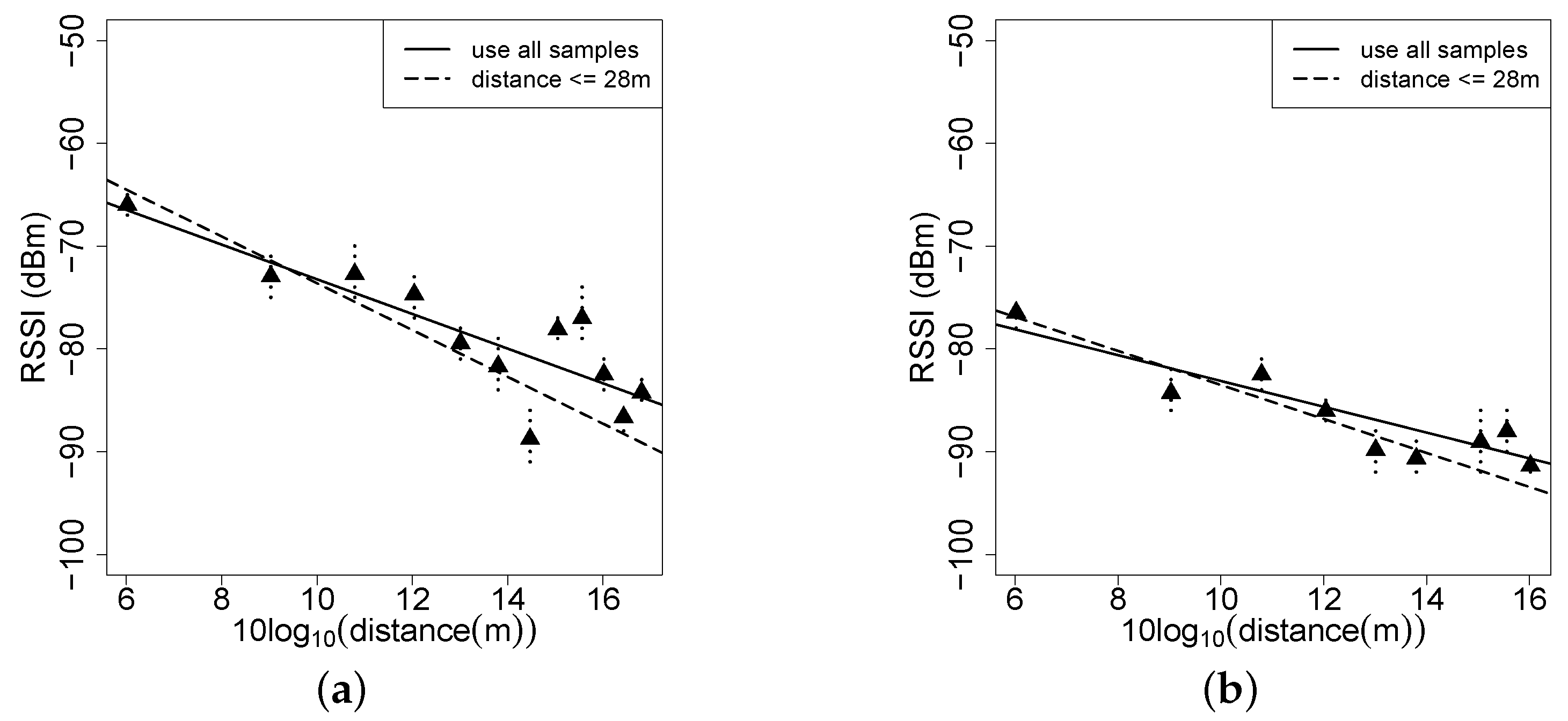
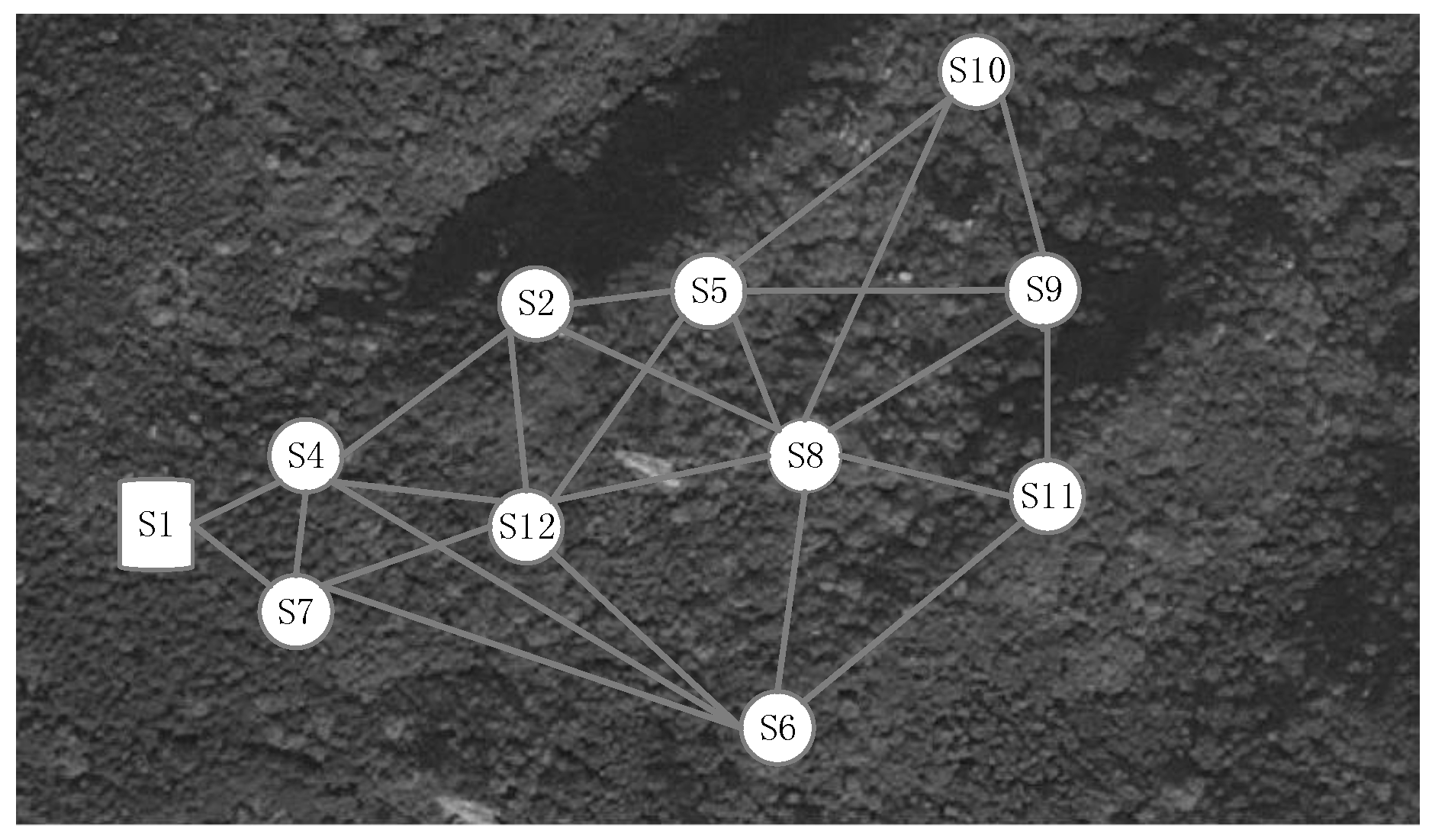

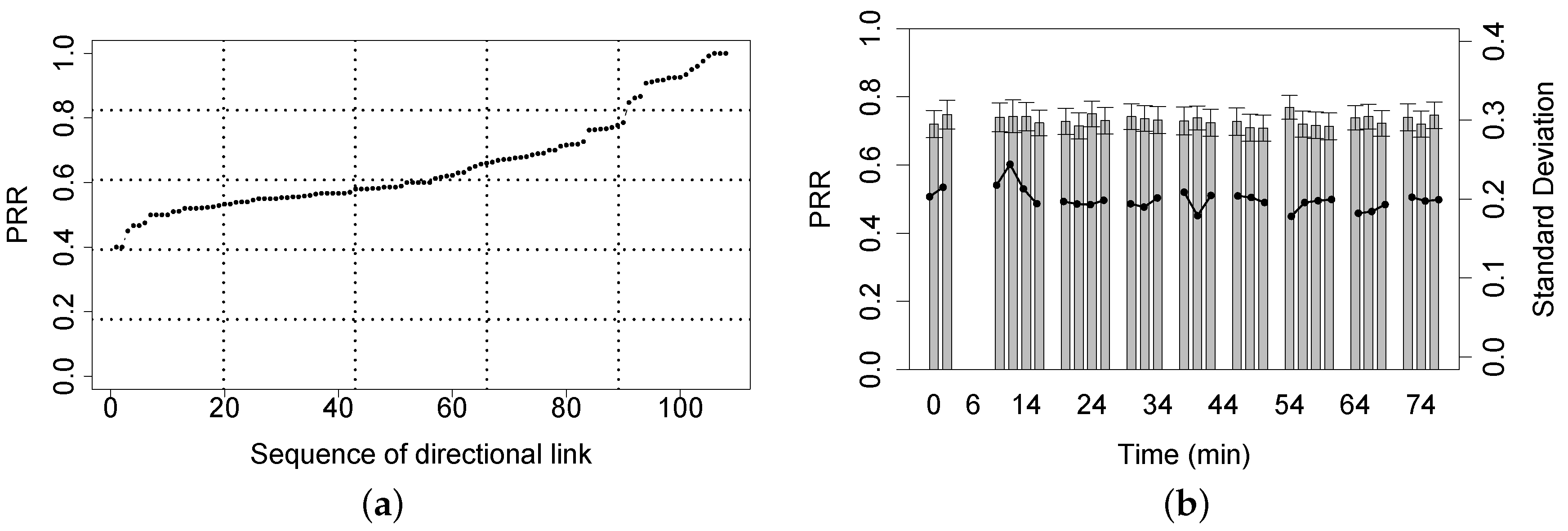
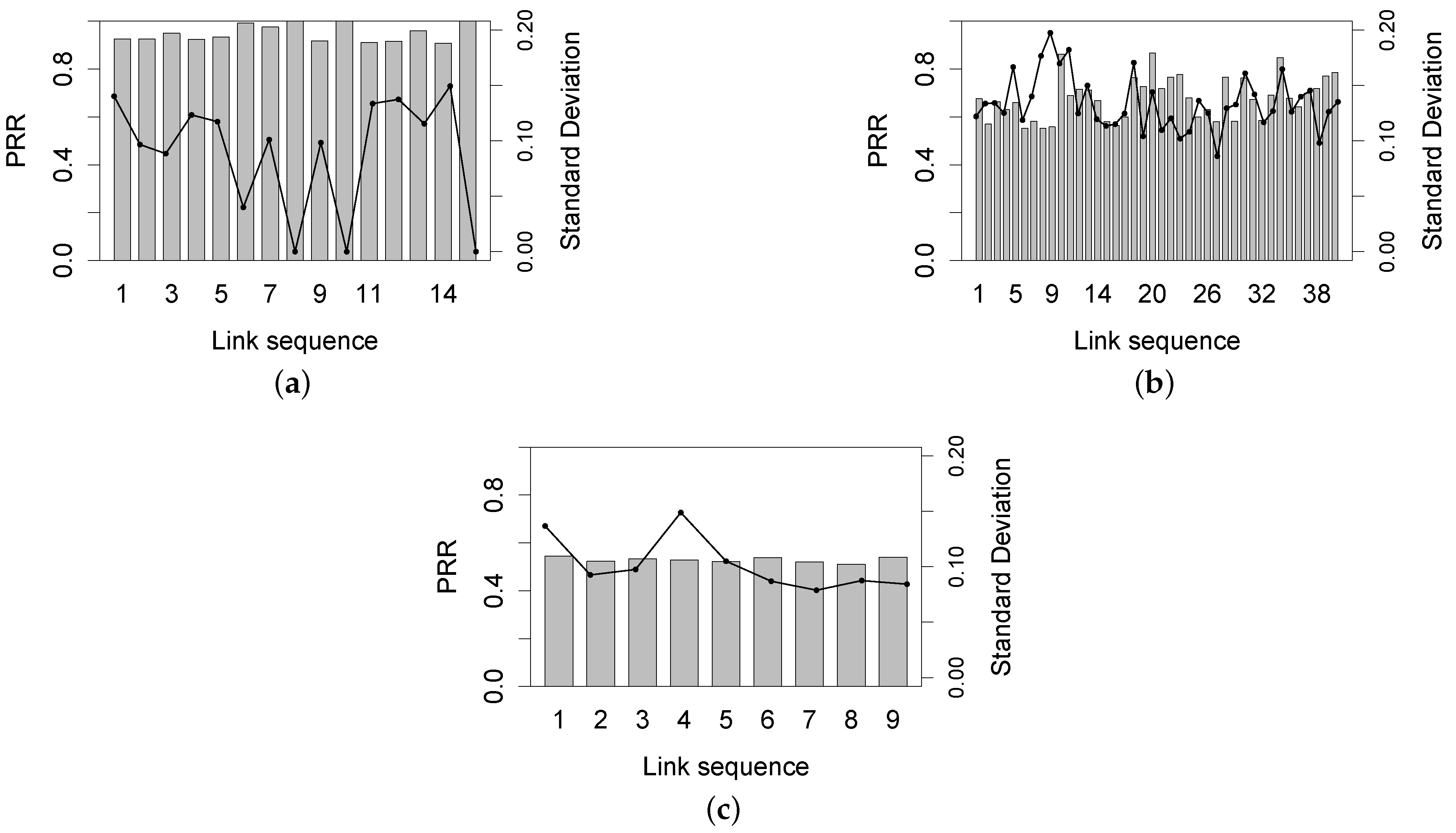



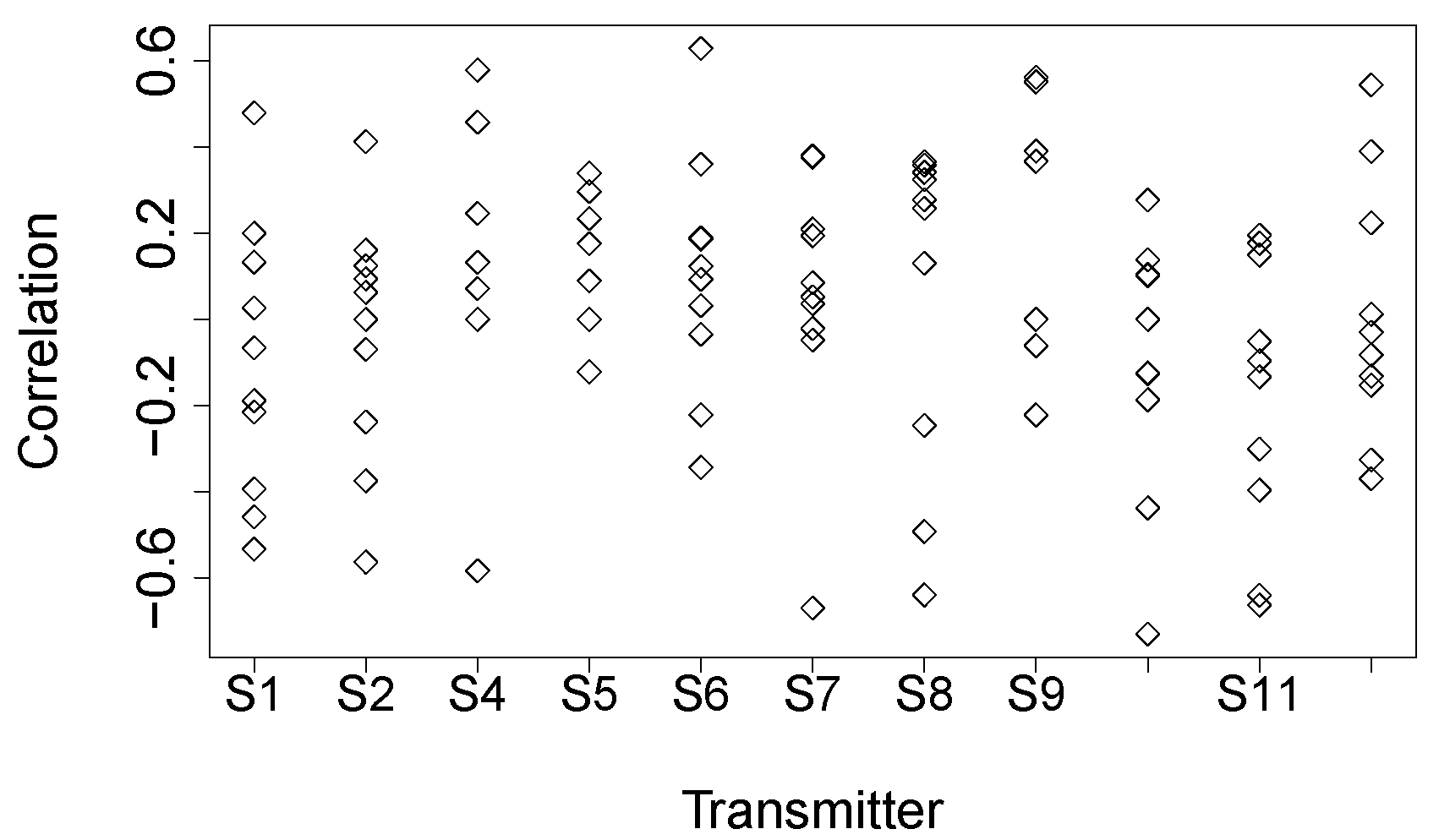
© 2016 by the authors; licensee MDPI, Basel, Switzerland. This article is an open access article distributed under the terms and conditions of the Creative Commons Attribution (CC-BY) license (http://creativecommons.org/licenses/by/4.0/).
Share and Cite
Ding, X.; Sun, G.; Yang, G.; Shang, X. Link Investigation of IEEE 802.15.4 Wireless Sensor Networks in Forests. Sensors 2016, 16, 987. https://doi.org/10.3390/s16070987
Ding X, Sun G, Yang G, Shang X. Link Investigation of IEEE 802.15.4 Wireless Sensor Networks in Forests. Sensors. 2016; 16(7):987. https://doi.org/10.3390/s16070987
Chicago/Turabian StyleDing, Xingjian, Guodong Sun, Gaoxiang Yang, and Xinna Shang. 2016. "Link Investigation of IEEE 802.15.4 Wireless Sensor Networks in Forests" Sensors 16, no. 7: 987. https://doi.org/10.3390/s16070987




